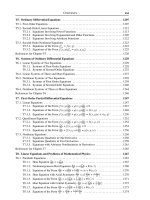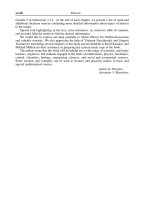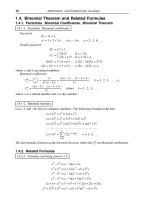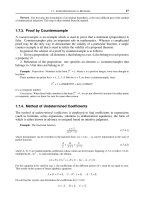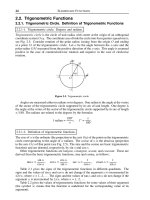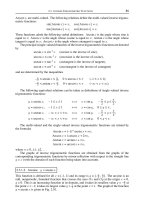Handbook of mathematics for engineers and scienteists part 199 pptx
Bạn đang xem bản rút gọn của tài liệu. Xem và tải ngay bản đầy đủ của tài liệu tại đây (290.2 KB, 7 trang )
1354 SYSTEMS OF PARTIAL DIFFERENTIAL EQUATIONS
2
◦
. A periodic solution in time:
u = r(x)cos
θ(x)+C
1
t + C
2
, w = r(x)sin
θ(x)+C
1
t + C
2
,
where C
1
and C
2
are arbitrary constants, and the functions r = r(x)andθ = θ(x)are
determined by the autonomous system of ordinary differential equations
ar
xx
– ar(θ
x
)
2
+ rf(r
2
)=0,
arθ
xx
+ 2ar
x
θ
x
– C
1
r + rg(r
2
)=0.
3
◦
. Solution (generalizes the solution of Item 2
◦
):
u = r(z)cos
θ(z)+C
1
t + C
2
, w = r(z)sin
θ(z)+C
1
t + C
2
, z = x + λt,
where C
1
, C
2
,andλ are arbitrary constants, and the functions r = r(z)andθ = θ(z)are
determined by the system of ordinary differential equations
ar
zz
– ar(θ
z
)
2
– λr
z
+ rf(r
2
)=0,
arθ
zz
+ 2ar
z
θ
z
– λrθ
z
– C
1
r + rg(r
2
)=0.
20.
∂u
∂t
= a
∂
2
u
∂x
2
+ uf
u
2
+ w
2
– wg
u
2
+ w
2
– w arctan
w
u
h
u
2
+ w
2
,
∂w
∂t
= a
∂
2
w
∂x
2
+ wf
u
2
+ w
2
+ ug
u
2
+ w
2
+ u arctan
w
u
h
u
2
+ w
2
.
Functional separable solution (for fixed t,itdefines a structure periodic in x):
u = r(t)cos
ϕ(t)x + ψ(t)
, w = r(t)sin
ϕ(t)x + ψ(t)
,
where the functions r = r(t), ϕ = ϕ(t), and ψ = ψ(t) are determined by the autonomous
system of ordinary differential equations
r
t
=–arϕ
2
+ rf(r
2
),
ϕ
t
= h(r
2
)ϕ,
ψ
t
= h(r
2
)ψ + g(r
2
).
T10.3.1-5. Arbitrary functions depend on the difference of squares of the unknowns.
21.
∂u
∂t
= a
∂
2
u
∂x
2
+ uf(u
2
– w
2
) + wg(u
2
– w
2
),
∂w
∂t
= a
∂
2
w
∂x
2
+ ug(u
2
– w
2
) + wf(u
2
– w
2
).
1
◦
. Solution:
u = ψ(t)coshϕ(x, t), w = ψ(t)sinhϕ(x, t), ϕ(x, t)=C
1
x +
g(ψ
2
) dt + C
2
,
where C
1
and C
2
are arbitrary constants, and the function ψ = ψ(t) is described by the
separable first-order ordinary differential equation
ψ
t
= ψf(ψ
2
)+aC
2
1
ψ,
T10.3. NONLINEAR SYSTEMS OF TWO SECOND-ORDER EQUATIONS 1355
whose general solution can be represented in implicit form as
dψ
ψf(ψ
2
)+aC
2
1
ψ
= t + C
3
.
2
◦
. Solution:
u = r(x)cosh
θ(x)+C
1
t + C
2
, w = r(x)sinh
θ(x)+C
1
t + C
2
,
where C
1
and C
2
are arbitrary constants, and the functions r = r(x)andθ = θ(x)are
determined by the autonomous system of ordinary differential equations
ar
xx
+ ar(θ
x
)
2
+ rf(r
2
)=0,
arθ
xx
+ 2ar
x
θ
x
+ rg(r
2
)–C
1
r = 0.
3
◦
. Solution (generalizes the solution of Item 2
◦
):
u = r(z)cosh
θ(z)+C
1
t + C
2
, w = r(z)sinh
θ(z)+C
1
t + C
2
, z = x + λt,
where C
1
, C
2
,andλ are arbitrary constants, and the functions r = r(z)andθ = θ(z)are
determined by the autonomous system of ordinary differential equations
ar
zz
+ ar(θ
z
)
2
– λr
z
+ rf(r
2
)=0,
arθ
zz
+ 2ar
z
θ
z
– λrθ
z
– C
1
r + rg(r
2
)=0.
22.
∂u
∂t
= a
∂
2
u
∂x
2
+ uf
u
2
– w
2
+ wg
u
2
– w
2
+ w arctanh
w
u
h
u
2
– w
2
,
∂w
∂t
= a
∂
2
w
∂x
2
+ wf
u
2
– w
2
+ ug
u
2
– w
2
+ u arctanh
w
u
h
u
2
– w
2
.
Functional separable solution:
u = r(t)cosh
ϕ(t)x + ψ(t)
, w = r(t)sinh
ϕ(t)x + ψ(t)
,
where the functions r = r(t), ϕ = ϕ(t), and ψ = ψ(t) are determined by the autonomous
system of ordinary differential equations
r
t
= arϕ
2
+ rf(r
2
),
ϕ
t
= h(r
2
)ϕ,
ψ
t
= h(r
2
)ψ + g(r
2
).
T10.3.1-6. Arbitrary functions depend on the unknowns in a complex way.
23.
∂u
∂t
= a
∂
2
u
∂x
2
+ u
k+1
f(ϕ), ϕ = u exp
–
w
u
,
∂w
∂t
= a
∂
2
w
∂x
2
+ u
k+1
[f(ϕ)lnu + g(ϕ)].
Solution:
u =(C
1
t + C
2
)
–
1
k
y(ξ), w =(C
1
t + C
2
)
–
1
k
z(ξ)–
1
k
ln(C
1
t + C
2
)y(ξ)
, ξ =
x + C
3
√
C
1
t + C
2
,
1356 SYSTEMS OF PARTIAL DIFFERENTIAL EQUATIONS
where C
1
, C
2
,andC
3
are arbitrary constants, and the functions y = y(ξ)andz = z(ξ)are
determined by the system of ordinary differential equations
ay
ξξ
+
1
2
C
1
ξy
ξ
+
C
1
k
y + y
k+1
f(ϕ)=0, ϕ = y exp
–
z
y
,
az
ξξ
+
1
2
C
1
ξz
ξ
+
C
1
k
z +
C
1
k
y + y
k+1
[f(ϕ)lny + g(ϕ)] = 0.
24.
∂u
∂t
= a
∂
2
u
∂x
2
+uf(u
2
+w
2
)–wg
w
u
,
∂w
∂t
= a
∂
2
w
∂x
2
+ug
w
u
+wf(u
2
+w
2
).
Solution:
u = r(x, t)cosϕ(t), w = r(x, t)sinϕ(t),
where the function ϕ = ϕ(t) is determined by the autonomous ordinary differential equation
ϕ
t
= g(tan ϕ), (1)
and the function r = r(x, t) is determined by the differential equation
∂r
∂t
= a
∂
2
r
∂x
2
+ rf(r
2
). (2)
The general solution of equation (1) is expressed in implicit form as
dϕ
g(tan ϕ)
= t + C.
Equation (2) admits an exact, traveling-wave solution r = r(z), where z = kx – λt with
arbitrary constants k and λ, and the function r(z) is determined by the autonomous ordinary
differential equation
ak
2
r
zz
+ λr
z
+ rf(r
2
)=0.
For other exact solutions to equation (2) for various functions f , see Polyanin and Zaitsev
(2004).
25.
∂u
∂t
= a
∂
2
u
∂x
2
+uf(u
2
–w
2
)+wg
w
u
,
∂w
∂t
= a
∂
2
w
∂x
2
+ug
w
u
+wf(u
2
–w
2
).
Solution:
u = r(x, t)coshϕ(t), w = r(x, t)sinhϕ(t),
where the function ϕ = ϕ(t) is determined by the autonomous ordinary differential equation
ϕ
t
= g(tanh ϕ), (1)
and the function r = r(x, t) is determined by the differential equation
∂r
∂t
= a
∂
2
r
∂x
2
+ rf(r
2
). (2)
The general solution of equation (1) is expressed in implicit form as
dϕ
g(tanh ϕ)
= t + C.
Equation (2) admits an exact, traveling-wave solution r = r(z), where z = kx – λt with
arbitrary constants k and λ, and the function r(z) is determined by the autonomous ordinary
differential equation
ak
2
r
zz
+ λr
z
+ rf(r
2
)=0.
For other exact solutions to equation (2) for various functions f , see Polyanin and Zaitsev
(2004).
T10.3. NONLINEAR SYSTEMS OF TWO SECOND-ORDER EQUATIONS 1357
T10.3.2. Systems of the Form
∂u
∂t
=
a
x
n
∂
∂x
x
n
∂u
∂x
+ F (u, w),
∂w
∂t
=
b
x
n
∂
∂x
x
n
∂w
∂x
+ G(u, w)
T10.3.2-1. Arbitrary functions depend on a linear combination of the unknowns.
1.
∂u
∂t
=
a
x
n
∂
∂x
x
n
∂u
∂x
+ uf(bu – cw) + g(bu – cw),
∂w
∂t
=
a
x
n
∂
∂x
x
n
∂w
∂x
+ wf(bu – cw) + h(bu – cw).
1
◦
. Solution:
u = ϕ(t)+c exp
f(bϕ – cψ) dt
θ(x, t),
w = ψ(t)+b exp
f(bϕ – cψ) dt
θ(x, t),
where ϕ = ϕ(t)andψ = ψ(t) are determined by the autonomous system of ordinary
differential equations
ϕ
t
= ϕf(bϕ – cψ)+g(bϕ – cψ),
ψ
t
= ψf(bϕ – cψ)+h(bϕ – cψ),
and the function θ = θ(x, t) satisfies linear heat equation
∂θ
∂t
=
a
x
n
∂
∂x
x
n
∂θ
∂x
.(1)
2
◦
. Let us multiply the first equation by b and the second one by –c and add the results
together to obtain
∂ζ
∂t
=
a
x
n
∂
∂x
x
n
∂ζ
∂x
+ ζf(ζ)+bg(ζ)–ch(ζ), ζ = bu – cw.(2)
This equation will be considered in conjunction with the first equation of the original system
∂u
∂t
=
a
x
n
∂
∂x
x
n
∂u
∂x
+ uf(ζ)+g(ζ). (3)
Equation (2) can be treated separately. Given a solution ζ = ζ(x, t) to equation (2), the
function u = u(x, t) can be determined by solving the linear equation (3) and the function
w = w(x, t) is found as w =(bu – ζ)/c.
Note two important solutions to equation (2):
(i) In the general case, equation (2) admits steady-state solutions ζ = ζ(x). The corre-
sponding exact solutions to equation (3) are expressed as u = u
0
(x)+
e
β
n
t
u
n
(x).
(ii) If the condition ζf(ζ)+bg(ζ)–ch(ζ)=k
1
ζ + k
0
holds, equation (2) is linear,
∂ζ
∂t
=
a
x
n
∂
∂x
x
n
∂ζ
∂x
+ k
1
ζ + k
0
,
and hence can bereduced to thelinear heat equation (1) with thesubstitution ζ =e
k
1
t
¯
ζ–k
0
k
–1
1
.
1358 SYSTEMS OF PARTIAL DIFFERENTIAL EQUATIONS
2.
∂u
∂t
=
a
x
n
∂
∂x
x
n
∂u
∂x
+ e
λu
f(λu – σw),
∂w
∂t
=
b
x
n
∂
∂x
x
n
∂w
∂x
+ e
σw
g(λu – σw).
Solution:
u = y(ξ)–
1
λ
ln(C
1
t + C
2
), w = z(ξ)–
1
σ
ln(C
1
t + C
2
), ξ =
x
√
C
1
t + C
2
,
where C
1
and C
2
are arbitrary constants, and the functions y = y(ξ)andz = z(ξ)are
determined by the system of ordinary differential equations
aξ
–n
(ξ
n
y
ξ
)
ξ
+
1
2
C
1
ξy
ξ
+
C
1
λ
+ e
λy
f(λy – σz)=0,
bξ
–n
(ξ
n
z
ξ
)
ξ
+
1
2
C
1
ξz
ξ
+
C
1
σ
+ e
σz
g(λy – σz)=0.
T10.3.2-2. Arbitrary functions depend on the ratio of the unknowns.
3.
∂u
∂t
=
a
x
n
∂
∂x
x
n
∂u
∂x
+ uf
u
w
,
∂w
∂t
=
b
x
n
∂
∂x
x
n
∂w
∂x
+ wg
u
w
.
1
◦
. Multiplicative separable solution:
u = x
1–n
2
[C
1
J
ν
(kx)+C
2
Y
ν
(kx)]ϕ(t), ν =
1
2
|n – 1|,
w = x
1–n
2
[C
1
J
ν
(kx)+C
2
Y
ν
(kx)]ψ(t),
where C
1
, C
2
,andk are arbitrary constants, J
ν
(z)andY
ν
(z) are Bessel functions, and the
functions ϕ = ϕ(t)andψ = ψ(t) are determined by the autonomous system of ordinary
differential equations
ϕ
t
=–ak
2
ϕ + ϕf(ϕ/ψ),
ψ
t
=–bk
2
ψ + ψg(ϕ/ψ).
2
◦
. Multiplicative separable solution:
u = x
1–n
2
[C
1
I
ν
(kx)+C
2
K
ν
(kx)]ϕ(t), ν =
1
2
|n – 1|,
w = x
1–n
2
[C
1
I
ν
(kx)+C
2
K
ν
(kx)]ψ(t),
where C
1
, C
2
,andk are arbitrary constants, I
ν
(z)andK
ν
(z) are modified Bessel functions,
and the functions ϕ = ϕ(t)andψ = ψ(t) are determined by the autonomous system of
ordinary differential equations
ϕ
t
= ak
2
ϕ + ϕf(ϕ/ψ),
ψ
t
= bk
2
ψ + ψg(ϕ/ψ).
3
◦
. Multiplicative separable solution:
u = e
–λt
y(x), w = e
–λt
z(x),
T10.3. NONLINEAR SYSTEMS OF TWO SECOND-ORDER EQUATIONS 1359
where λ is an arbitrary constant and the functions y = y(x)andz = z(x) are determined by
the system of ordinary differential equations
ax
–n
(x
n
y
x
)
x
+ λy + yf(y/z)=0,
bx
–n
(x
n
z
x
)
x
+ λz + zg(y/z)=0.
4
◦
. This is a special case of equation with b = a.Letk be a root of the algebraic (transcen-
dental) equation
f(k)=g(k).
Solution:
u = ke
λt
θ, w = e
λt
θ, λ = f (k),
where the function θ = θ(x, t) satisfies the linear heat equation
∂θ
∂t
=
a
x
n
∂
∂x
x
n
∂θ
∂x
.(1)
5
◦
. This is a special case of equation with b = a. Solution:
u = ϕ(t)exp
g(ϕ(t)) dt
θ(x, t), w =exp
g(ϕ(t)) dt
θ(x, t),
where the function ϕ = ϕ(t) is described by the separable first-order nonlinear ordinary
differential equation
ϕ
t
=[f(ϕ)–g(ϕ)]ϕ,(2)
and the function θ = θ(x, t) satisfies the linear heat equation (1).
To the particular solution ϕ = k = const of equation (2), there corresponds the solution
presented in Item 4
◦
. The general solution of equation (2) is written out in implicit form as
dϕ
[f(ϕ)–g(ϕ)]ϕ
= t + C.
4.
∂u
∂t
=
a
x
n
∂
∂x
x
n
∂u
∂x
+ uf
u
w
+
u
w
h
u
w
,
∂w
∂t
=
a
x
n
∂
∂x
x
n
∂w
∂x
+ wg
u
w
+ h
u
w
.
Solution:
u = ϕ(t)G(t)
θ(x, t)+
h(ϕ)
G(t)
dt
, w = G(t)
θ(x, t)+
h(ϕ)
G(t)
dt
, G(t)=exp
g(ϕ) dt
,
where the function ϕ = ϕ(t) is described by the separable first-order nonlinear ordinary
differential equation
ϕ
t
=[f(ϕ)–g(ϕ)]ϕ,(1)
and the function θ = θ(x, t) satisfies the linear heat equation
∂θ
∂t
=
a
x
n
∂
∂x
x
n
∂θ
∂x
.
The general solution of equation (1) is written out in implicit form as
dϕ
[f(ϕ)–g(ϕ)]ϕ
= t + C.
1360 SYSTEMS OF PARTIAL DIFFERENTIAL EQUATIONS
5.
∂u
∂t
=
a
x
n
∂
∂x
x
n
∂u
∂x
+ uf
1
w
u
+ wg
1
w
u
,
∂w
∂t
=
a
x
n
∂
∂x
x
n
∂w
∂x
+ uf
2
w
u
+ wg
2
w
u
.
Solution:
u=exp
[f
1
(ϕ)+ϕg
1
(ϕ)] dt
θ(x, t), w(x, t)=ϕ(t)exp
[f
1
(ϕ)+ϕg
1
(ϕ)] dt
θ(x, t),
where the function ϕ = ϕ(t) is described by the separable first-order nonlinear ordinary
differential equation
ϕ
t
= f
2
(ϕ)+ϕg
2
(ϕ)–ϕ[f
1
(ϕ)+ϕg
1
(ϕ)],
and the function θ = θ(x, t) satisfies the linear heat equation
∂θ
∂t
=
a
x
n
∂
∂x
x
n
∂θ
∂x
.
6.
∂u
∂t
=
a
x
n
∂
∂x
x
n
∂u
∂x
+u
k
f
u
w
,
∂w
∂t
=
b
x
n
∂
∂x
x
n
∂w
∂x
+w
k
g
u
w
.
Self-similar solution:
u =(C
1
t + C
2
)
1
1–k
y(ξ), w =(C
1
t + C
2
)
1
1–k
z(ξ), ξ =
x
√
C
1
t + C
2
,
where C
1
and C
2
are arbitrary constants, and the functions y = y(ξ)andz = z(ξ)are
determined by the system of ordinary differential equations
aξ
–n
(ξ
n
y
ξ
)
ξ
+
1
2
C
1
ξy
ξ
+
C
1
k – 1
y + y
k
f(y/z)=0,
bξ
–n
(ξ
n
z
ξ
)
ξ
+
1
2
C
1
ξz
ξ
+
C
1
k – 1
z + z
k
g(y/z)=0.
7.
∂u
∂t
=
a
x
n
∂
∂x
x
n
∂u
∂x
+ uf
u
w
ln u + ug
u
w
,
∂w
∂t
=
a
x
n
∂
∂x
x
n
∂w
∂x
+ wf
u
w
ln w + wh
u
w
.
Solution:
u = ϕ(t)ψ(t)θ(x, t), w = ψ(t)θ(x, t),
where the functions ϕ = ϕ(t)andψ = ψ(t) are determined by solving the autonomous
ordinary differential equations
ϕ
t
= ϕ[g(ϕ)–h(ϕ)+f(ϕ)lnϕ],
ψ
t
= ψ[h(ϕ)+f(ϕ)lnψ],
(1)
and the function θ = θ(x, t) is determined by the differential equation
∂θ
∂t
=
a
x
n
∂
∂x
x
n
∂θ
∂x
+ f(ϕ)θ ln θ.(2)



